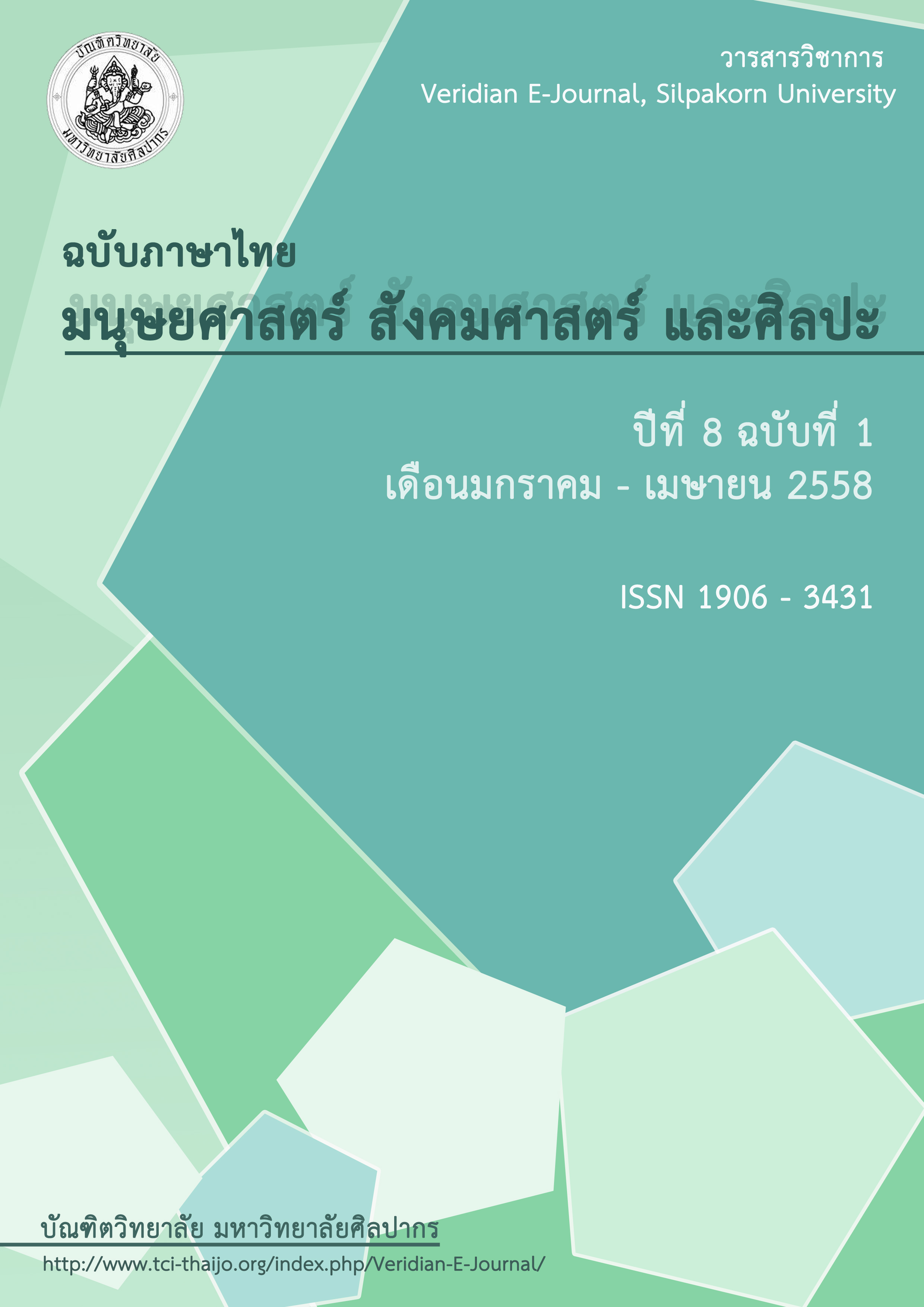การสร้างสื่อนิทานเพื่อพัฒนาพฤติกรรมคุณธรรมด้านความมีน้ำใจในเด็กปฐมวัย
Main Article Content
Abstract
บทคัดย่อ
การวิจัยครั้งนี้มีวัตถุประสงค์คือ 1) เพื่อสร้างนิทานต้นแบบซึ่งใช้หลักการสื่อสารเพื่อการโน้มน้าวใจและหลักการสร้างนิทานสำหรับเด็กปฐมวัยอย่างมีระบบและขั้นตอน 2) เพื่อศึกษาประสิทธิภาพของสื่อนิทานที่สร้างขึ้นต่อพฤติกรรมคุณธรรมความมีน้ำใจของเด็กปฐมวัย โดยมีสมมติฐานในการวิจัยคือ 1) นิทานต้นแบบซึ่งใช้หลักการสื่อสารเพื่อการโน้มน้าวใจและหลักการสร้างนิทานสำหรับเด็กปฐมวัยอย่างมีระบบและขั้นตอนมีประสิทธิภาพตามเกณฑ์ 2) ค่าเฉลี่ยคะแนนพฤติกรรมคุณธรรมด้านความมีน้ำใจในเด็กปฐมวัยของกลุ่มตัวอย่างหลังการทดลองสูงกว่าก่อนการทดลอง
การวิจัยครั้งนี้เป็นการวิจัยเชิงทดลองเบื้องต้น (Pre experimental design) แบบ The One-group pre-test post-test Design กลุ่มตัวอย่างที่ใช้ในการวิจัยครั้งนี้เป็นนักเรียนชั้นอนุบาลปีที่ 2 ทั้งเพศชายและหญิงอายุ 5-6 ปีจำนวน 1 ห้องเรียนรวม 36 คนหนังสือนิทานผู้วิจัยเป็นผู้สร้างขึ้นเองโดยอาศัยหลักการสร้างนิทานสำหรับเด็กปฐมวัยและหลักการสื่อสารเพื่อการโน้มน้าวใจให้เด็กปฐมวัยรู้จักการมีน้ำใจช่วยเหลือและรู้จักการแบ่งปันให้ผู้อื่นและสังคมจำนวน 2 เรื่องในรูปแบบหนังสือทั่วไปและหนังสืออิเล็กทรอนิกส์ (E-book) เพื่อนำไปใช้สอบถามความคิดเห็นเพิ่มเติมจากผู้ปกครองในช่องทางการสื่อสารผ่านเครือข่ายอินเทอร์เน็ต ประสิทธิภาพของนิทาน (E1/E2) กำหนดเกณฑ์ไว้ที่ 80/80 หนังสือนิทานที่พัฒนาจนมีประสิทธิภาพตามเกณฑ์แล้วได้นำไปใช้ในการทดลอง 10 สัปดาห์โดยมีครูเป็นผู้เล่านิทาน ก่อนและหลังการทดลองมีการวัดพฤติกรรมคุณธรรมด้านความมีน้ำใจของกลุ่มตัวอย่าง หาค่าความแตกต่างของคะแนนเฉลี่ยพฤติกรรมคุณธรรมด้านความมีน้ำใจก่อนและหลังการทดลองโดยใช้Dependent Sample t-test
ผลการวิจัยพบว่าผลการทดสอบประสิทธิภาพของสื่อนิทานที่ผู้วิจัยสร้างได้ค่าประสิทธิภาพ 86.11/84.25 ซึ่งสูงกว่าเกณฑ์ที่ตั้งไว้ การสร้างสื่อนิทานให้มีประสิทธิภาพนั้นพบว่าการกำหนดวัตถุประสงค์
ในการสร้างอย่างชัดเจนและการศึกษาข้อมูลเพื่อสร้างเนื้อหาภาษารูปเล่มภาพประกอบคู่มือในการเล่านิทานรวมถึงการใช้เทคนิคเพื่อให้นิทานมีความน่าสนใจได้แก่การสร้างนิทานสองเรื่องโดยให้ตัวละครมีความแตกต่างกันแบบคู่ตรงข้ามการจูงใจโดยใช้ความกลัวรวมถึงการใส่เนื้อหาที่ทำให้เด็กมีส่วนร่วมเช่นเสียงร้อง
ของตัวละครสามารถกระตุ้นความสนใจได้เป็นอย่างดีนอกจากนี้การสร้างตัวละครที่มีความน่าสนใจและเป็นแบบอย่างที่ดีจะทำให้เด็กชื่นชอบและเลียนแบบพฤติกรรมที่ดีของตัวละคร ซึ่งสอดคล้องกับความคิดเห็นจาก
ผู้ปกครองที่สอบถามผ่านเครือข่ายอินเทอร์เน็ตที่พบว่านิทานอิเล็กทรอนิกส์ที่สร้างขึ้นทั้งสองเรื่องนั้น
เนื้อเรื่อง ภาษา ภาพประกอบตัวละครมีความเหมาะสมและน่าสนใจ บุตรหลานของทุกคนชอบและตั้งใจฟังนิทาน
สื่อนิทานที่ผู้วิจัยสร้างขึ้นนี้มีผลต่อการปรับเปลี่ยนพฤติกรรมคุณธรรมความมีน้ำใจของกลุ่มตัวอย่างโดยค่าคะแนนเฉลี่ยการทำแบบทดสอบพฤติกรรมคุณธรรมด้านความมีน้ำใจหลังการทดลองสูงกว่าก่อนการทดลองเล่านิทานอย่างมีนัยสำคัญทางสถิติที่ระดับ .05 จากการสังเกตพบว่าหลังการทดลองเล่านิทานครั้งแรกกลุ่มตัวอย่างแสดงพฤติกรรมความมีน้ำใจต่อครูและเพื่อนเพิ่มมากขึ้นนอกจากนี้กลุ่มตัวอย่างยังเลียนแบบพฤติกรรมที่ดีของตัวละครอีกด้วย
สื่อนิทานที่มีประสิทธิภาพและมีความน่าสนใจสามารถพัฒนาพฤติกรรมคุณธรรมด้านความมีน้ำใจในเด็กปฐมวัยได้ ดังนั้นภาครัฐ สถาบันการศึกษา ครูและผู้ปกครองควรให้ความสำคัญกับการใช้สื่อนิทานโดยการสร้างหรือเลือกสื่อนิทานที่มีประสิทธิภาพ มีความเหมาะสมและมีความน่าสนใจมาใช้ปลูกฝังและพัฒนาคุณลักษณะอันพึงประสงค์หรือเพื่อลดพฤติกรรมที่ไม่พึงประสงค์ในเด็กปฐมวัย
Abstract
The purposes of this study were: (1) to develop model tales using principles of persuasive communication and principles of tale development to enhance generosity behaviors in early childhood pupils; (2) to assess the effectiveness of the developed tales on the generosity behaviors of early childhood pupils. For the second objective, two hypotheses were formulated: (1) the tales constructed to enhance the generosity behaviors were effective; (2) the mean score on the generosity behaviors after the implementation of the tales was higher than that before the use of the materials.
The research is a pre-experimental (one group pretest and posttest design). The subjects chosen for this study were 36 male and female pupils of a Kindergarten Level 2 class, aged 5 – 6 years old. The research instruments were two tale books, constructed by the researcher. The tale books were based on the principles of persuasive communication and principles of tale construction. The tales aimed at enhancing the ethical behaviors of generosity in children in early childhood pupils. The tales constructed were also to establish the value of generosity and to encourage sharing among others of kindergarten pupils. The books of tales were published in printed and electronic formats. Early childhood children’s parents were also surveyed through the internet to find out the effectiveness of the tales constructed. The effectiveness criteria of the tales were set at a level of 80/80. After the tales were constructed, they were tested and revised until the effectiveness reached the expected criteria level. The tales were implemented in a kindergarten classroom for 10 weeks. The pretest was given to the subjects before the experiment to measure their level of generosity. The tales were told to the subjects by the classroom teacher. After the experiment the posttest was given to measure the subjects’ scores on generosity. A dependent sample t-test was used to determine the difference between the mean scores of generosity of the subjects before and after the treatment.
The results of the study were:
(1) The effectiveness of the tales constructed was 86.11/84.25, which was higher than the expected criteria. It was found that the tales had clear objectives, correct content, suitable background, beautiful layout and illustrations. The presentation techniques were suitable and interesting. The characters in the two tales were divided clearly into two opposite character traits – good and bad ones. “Fear” was the motivation used in the tales. The tales also included words and phrases that motivated students to participate in the story telling such as cries of characters. The characters were interesting and they were good models for pupils to follow. The parents who were surveyed through the internet revealed positive opinions. They agreed that the tales had suitable content, illustrations, and characters. The parents who participated in the study also agreed that the tales were interesting and motivating. Early childhood children listened to the tales attentively.
(2) The mean score of the posttest was significantly higher than that of the pretest at the significant level of .05. This indicated that the tales constructed could change the ethical behavior of generosity of the subjects. The data from observation also revealed that after the implementation of the first tale the subjects showed generous behavior towards teachers and classmates. Some pupils imitated the behaviors of characters in the tales they had listened to.
Based on the research results, it is recommended that schools, teachers, and parents to use tales to develop the ethical behaviors of generosity. Developing and selecting suitable tales are important. Tales can be used to develop the ethical behavior of generosity of kindergarten pupils and also to lessen undesired behaviors.
